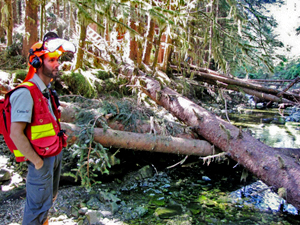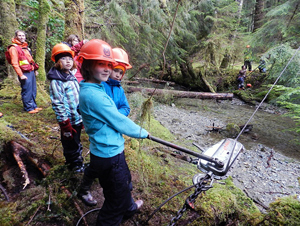Yahguudang Dlljuu: A Respectful Act
Gwaii Haanas National Park Reserve, National Marine Conservation Area Reserve, and Haida Heritage Site
How to Pronounce Yahguudang Dlljuu in Xaayda Kil
This translates to "A Respectful Act"
The Haida Nation celebrates more than 10,000 years of a sacred connection with the land and sea- its waters support the Haida’s traditional harvest of marine resources and commercial fisheries. Pacific salmon abundance along the West coast of Canada has been in sharp decline since the early 1990s, likely due to habitat destruction, overfishing, and warming stream temperatures caused, in part, by climate change.
Spawning grounds for salmon, an important food source for the Haida people, were damaged by intensive logging prior to establishment of this protected area. The Parks Canada Agency, in partnership with the Haida Nation, is restoring streams and old-growth forests in Gwaii Haanas to re-establish salmon populations. This habitat restoration project aims to enhance survival of salmon in the face of climate change while preserving the traditional lifestyle of the Haida Nation.
Gwaii Haanas salmon restoration field trip
Transcript
Animated Title Sequence: Parks Canada
[Students stand in front of the longhouse at Windy Bay]
Welcome to Gwaii Haanas!
[A montage showing the students making the journey from Skidegate Landing to Windy Bay on Lyell Island]
[One of the Zodiac pilots speaks]
They are a fast boat so the ride can be bouncy.
[Pictures of the youth on the boat ride to Windy Bay]
[Text] Parks Canada employee Jody Bissett
I am super-excited that we are offering for the third year in a row a chance for local students on Haida Gwaii to get down into Gwaii Haanas and experience the natural beauty and cultural wonder that is to be found there.
[Students get involved in restoration and ecological monitoring activities on Lyell Island]
[Text] Evan Garrett
Today was probably the most amazing day of my life. I've learned lots about Windy Bay and the habitat and the trees.
[Pictures of an old growth forest and stream at Windy Bay]
[Student crossing a stream]
[Students listen to Parks Canada biologist Peter Dyment about stream and riparian monitoring activities]
[Text] Solana Hepburn
This is my first time in Gwaii Haanas and I hope I come back.
[Group hiking through the forest, speeded up]
[Text] Nolan O’Brien
I'd say the best part of today was experiencing the whole adventure. I've never been to a place so natural and untouched, it's really beautiful.
[Students take video shots of sea lions from the Zodiac boat]
[More pictures of the kids taking part in stream monitoring activities]
[Text] Caden Ives / Jack Moseley
The best part of the day was when we were doing the donuts in the Zodiac.
[Pictures of the kids having fun on the Zodiac boat]
[Text] Lula Issa
It was a really awesome trip and I'd love to go on it again.
[Ernie Gladstone, superintendent of Gwaii Haanas National Park Reserve, National Marine Conservation Area Reserve, and Haida Heritage Site and guest speaker Colin Richardson, Haida Nation representative, talk to the group about the history of Lyell Island and the protection of Gwaii Haanas]
[Text] Tricia Jung (speaking) and Rachel Fraser
One of my favourite parts of the day was the talk that Ernie Gladstone and Colin Richardson gave. I think that the kids were all really engaged, just the rich history of the place we visited. I thought it was pretty amazing, all these organisations working together to create this opportunity.
[The group learns through play activities]
For the youth on Haida Gwaii to be able to feel a connection and to be proud of Gwaii Haanas and everything we have accomplished, I think is so important.
[The group gets ready to get on the Zodiac boats and leave Windy Bay]
[Text] David Putterill
It's been really cool here and I hope I come to Gwaii Haanas again.
[Timelapse of the return journey in the Zodiac boats]
[Text] Gwaii Haanas Salmon Restoration Field Trip, Lyell Island 2013
[Text] Parks Canada and Fisheries and Oceans Canada are working with the Council of the Haida Nation to restore the land and honour the history of Lyell Island.
[Text] Other partners in this project are: Hecate Strait Streamkeepers; Province of British Columbia.
[Text] Thanks to the participating schools and students:
Agnes L. Matthews Elementary: David Putterill
George M. Dawson Secondary: Amy Marks, Abigale McLeod, Dora Lynn Bedard
Port Clements Elementary: Gavin Wilson, Lula Issa
Queen Charlotte Secondary: Nolan O’Brien, Evan Garrett, Raven Ryland
Sk’aadgaa Naay Elementary: Jack Moseley, Caden Ives, Avery Robson-Brillon
Tahayghen Elementary: Brannon Bell, Solana Hepburn
Chief Matthews Elementary: Kailyn Swanson
Living and Learning School: Joelle Regier
And thanks to the chaperones: Jean Williams, Tricia Jung, Rachel Fraser, Arleigh Regier
Animated Title Sequence: Haida Nation and wordmark « Canada »
Restoring the Land and Honouring the History of Lyell Island
Two kilometres of stream in three logging-damaged creeks on Lyell Island have already been restored as part of unique initiative that aims to restore stream ecosystems so that salmon populations can re-establish in an area that was once heavily logged and to ensure local youth learn how to take care of the land and sea.
Tllga Kun Gwaayaay (Lyell Island) is the site of the 1985 standoff where Haida elders stood the line to protest unsustainable logging on their traditional lands.
 Moving logs into place on Lyell Island
Moving logs into place on Lyell Island © Parks Canada
The 19,000 ha island was first logged in the 1920s, but intensive clearcutting carried out in the late 1970s and into the 1980s led to slope instability and landslides.
During that time, logs were skidded through streambeds resulting in the destruction of salmon-bearing stream habitat.
Gwaii Haanas staff and partners have built more than a dozen in-creek structures by dropping large woody debris into three streams: Sandy, Powrivco and Takelly Creeks.
The land around the creeks is also being restored and several hectares of forest have been thinned to emulate old growth characteristics and ensure that conifer growth provides a future source of woody debris for the streams.
Over the last three years, future stewards have learned about protecting the land and sea in Gwaii Haanas. In 2011, a group of students representing every school on the islands helped release fry into a Lyell Island creek and in 2012, a similar group helped move large woody debris to encourage the creation of salmon rearing habitat.
Yahguudang dlljuu: A Respectful Act
 Students help move logs in 2012
Students help move logs in 2012 © Parks Canada
Chum (Oncorhynchus keta) broodstock are being collected from selected streams in the fall months and hatchery-raised to fry for release into restored streams in the spring.
In 1985, the Haida Nation designated Gwaii Haanas as a heritage site under the Haida Constitution.
In July 1987, logging on Lyell Island ended when Canada and British Columbia signed the South Moresby Memorandum of Understanding.
In 1993, the Gwaii Haanas Agreement was signed and for the last 20 years the Government of Canada and the Haida Nation have been working cooperatively to manage the land and sea.
By engaging community members and youth in direct participation in ecological restoration activities, and through engaging local schools in the salmon enhancement program, the project will foster an increased understanding of the importance of ecological integrity and the significance of Lyell Island to the people of Haida Gwaii and to all Canadians.
Working With Partners
Since 2004, Gwaii Haanas has been working with a range of partners including the Council of the Haida Nation’s Fisheries Program, the Hecate Strait Streamkeepers, Fisheries and Oceans Canada, Ministry of Forests, Lands and Natural Resource Operations as well as a range of community organizations.
This project is funded by the federal government as part of Parks Canada’s Action-on-the-Ground program, a nation-wide initiative that encourages Canadians to engage in activities that support conservation and promote the ecological integrity of Canada’s national parks and natural and cultural heritage.
- Date modified :